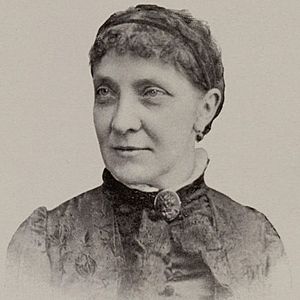Rachel Lloyd (chemist) facts for kids
Quick facts for kids
Rachel Lloyd
|
|
|---|---|

Portrait of Rachel Lloyd
|
|
| Born |
Rachel Abbie Holloway
January 26, 1839 Flushing, Ohio, US
|
| Died | March 7, 1900 (aged 61) |
| Alma mater | University of Zurich |
| Known for | Sugar Beet Chemistry & Agriculture First American female Ph.D in Chemistry |
| Scientific career | |
| Fields | Chemistry |
| Institutions | University of Nebraska |
| Thesis | On the conversion of some of the homologues of benzol-phenol into primary and secondary amines (1887) |
| Academic advisors | Charles F. Mabery |
Rachel Lloyd was an amazing American chemist who lived from 1839 to 1900. She is famous for her important work with sugar beets. She studied their chemistry and how to grow them better.
Rachel was a pioneer for women in science. She earned her doctorate degree in chemistry from the University of Zurich in 1886. This made her the first American woman to get a chemistry doctorate. She was also only the second woman in the world to achieve this!
She taught chemistry for many years at different schools. In 1891, she became the first woman to be a regular member of the American Chemical Society. Years later, in 2014, her work was honored as a National Historic Chemical Landmark. This special award recognized her big contributions to chemistry.
Contents
Who Was Rachel Lloyd?
Her Early Life
Rachel Abbie Holloway was born in Flushing, Ohio, in 1839. She grew up in a large farming family who were Quakers. Her parents were both teachers.
Rachel faced many challenges when she was young. She lost her mother when she was five. Her father passed away when she was 12.
She started attending Friends School in Flushing at age 13. She continued her studies at Westtown School in Pennsylvania. Rachel finished her schooling at Miss Margaret Robinson's School. She also started teaching there.
In 1859, Rachel married Franklin Lloyd, a chemist. She became interested in chemistry because Franklin had a lab at home. Sadly, Rachel faced more loss. Her two children and her husband passed away in 1865.
After these sad events, Rachel traveled in Europe for several years. She later returned to the U.S. and taught science. She then decided to focus on her growing interest in chemistry.
Becoming a Chemist
In 1876, Rachel started taking science classes at Harvard Summer School. She worked with a scientist named Charles F. Mabery. She continued her research there for eight years.
During this time, she also kept teaching. In 1883, she helped start the Louisville School of Pharmacy for Women. This school helped women learn about pharmacy.
In 1884, Rachel decided to study at the University of Zurich. At that time, it was one of the few places where women could earn a doctorate in chemistry. She earned her doctorate in 1886 when she was 48 years old.
Her research focused on changing certain chemicals into other forms. While studying, she also became very interested in the growing sugar beet industry.
Teaching and Research at the University of Nebraska
In 1887, Rachel Lloyd was offered a job at the University of Nebraska. She became an associate professor of analytical chemistry. She was the second person in the new Chemistry Department.
Rachel encouraged both young men and women to study chemistry. During her time there, the chemistry department had many women students. Between 1888 and 1915, 10 out of 46 chemistry students were women.
The University of Nebraska received money to create an Agricultural Experiment Station. Rachel's most important work was studying sugar in sugar beets. She used special tools like the saccharometer to measure sugar.
She studied sugar beets grown in different parts of Nebraska. Her reports in 1890 showed that growing sugar beets was profitable. This helped farmers in Nebraska a lot.
Sugar production in Nebraska grew hugely because of her work. It went from 736,000 pounds to over 8 million pounds in just five years! Her findings led to a new sugar refinery opening in Nebraska. It was the first one in the Midwest.
Rachel became a full professor in 1888. In 1892, she became the head of the chemistry department. She taught until 1894, when she had to resign due to health issues.
After she passed away, a university leader said she was a great teacher. He also said she was a beloved advisor to students. She connected with students through clubs like the Camera Club.
Her Final Years
Rachel Lloyd spent the last seven years of her life near Philadelphia, Pennsylvania. She wanted to be closer to her friends and family.
She passed away on March 7, 1900, from heart failure. She was buried with her husband and children in the Laurel Hill Cemetery in Philadelphia.
A Time Capsule Discovery
In May 2014, a special time capsule was opened at the University of Nebraska Lincoln. The capsule was placed in 1916 in the cornerstone of the old Chemistry Department building.
People had forgotten about it until someone found an old newspaper article. The article mentioned Rachel Lloyd and the capsule's burial.
The capsule held newspapers from 1916 and information about the university. It also had photos of chemistry department members. A very important item was a book about Rachel's life. It was written by her brother-in-law and contained new information about her.
Clubs and Groups
Rachel Lloyd was a member of many important groups. She belonged to the American Association for the Advancement of Science. She was also part of the Association for the Advancement of Women. Her most notable membership was in the American Chemical Society.
She was also a member of other groups, including the German Chemical Society and the English Chemical Society. She joined the Nebraska Academy of Sciences and the National American Woman Suffrage Association.

